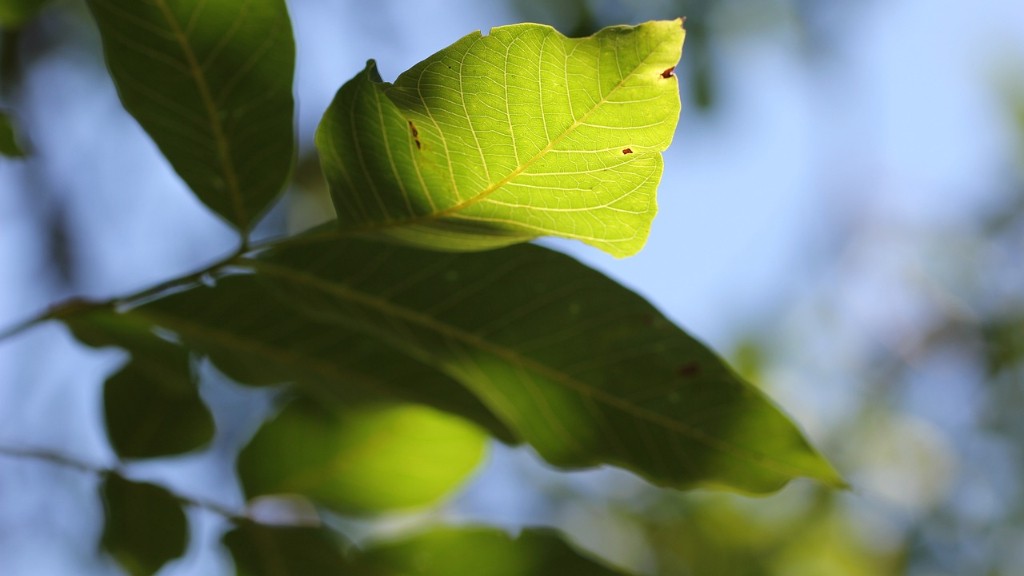Physical Description
Avocado trees are medium-sized evergreen trees reaching a height of up to 40 feet and generally having a trunk diameter of up to 24 inches. Their leaves are oval, leathery and glossy and may be four to eight inches in length. Avocado leaves also have sharp, jagged edges and are a dark green color, often with a reddish tint. The trees bear fruit in abundance, where small yellow or green flowers bloom in the springtime. The fruit is pear-shaped and typically ranges in size from four to twelve ounces. The avocado variety can determine the smoothness of the skin and the hue can range from dark purple to green.
Growth and Care
Avocado trees are not particularly cold-hardy and in colder climates, they should be grown in containers and brought indoors during the winter months to provide protection from frosts. These trees prefer a well-draining soil and benefits from regular fertilization and irrigation. Avocado trees will usually bear fruit within five to seven years of being planted, although this can vary depending on the variety.
Uses and Benefits
The avocado is a healthy and versatile fruit and is used in a broad range of dishes. It can be eaten raw, used to make guacamole, added to salads, sandwiches and wraps and can also be used to make smoothies, ice cream and even used in baking. One of the main health benefits of avocados is that they are high in essential fatty acids, vitamins and minerals which are important for good health. They are also a good source of dietary fiber and can help reduce cholesterol levels.
Diseases and Pests
Avocado trees can suffer from numerous diseases such as Leaf Spot and Root Rot, which is caused by a fungus called Phytophthora cinnamomi. The trees are also prone to plant pests such as whiteflies, mites, aphids and scale. All of these diseases and pests can be controlled with the use of pesticides, insecticides and fungicides.
Harvesting and Storing
Avocados are usually ready to harvest when they are around the size of a softball and the skin has begun to turn color. The best way to tell when an avocado is ripe is to carefully press the fruit with your hand, if it is soft but not mushy then it is ready to be harvested. Avocados should be stored in a cool dark place and should be consumed within a few days once picked as they do not store well.
Natural Pollinators
Avocado trees require cross-pollination from another variety of avocado in order to set fruit. This is usually achieved through the help of the bees and certain varieties of wasps and flies. The flowers on avocado trees have a long pollination season ranging from late spring to early summer, so a good selection of pollinators should be kept in the vicinity of your avocado tree.
Climate Requirements
Avocado trees prefer a Mediterranean climate but can also survive in temperate climates. In warm climates they should be grown in full sun but in cooler climates they will require some shade. Avocados thrive in moist soils so adequate water is necessary for a healthy and productive tree.
Drought Resistance
Avocado trees are known to be quite resilient and are tolerant to both warm and cold climates, however they are not as tolerant to dry spells as other fruit trees. Avocado trees will require a certain amount of water to remain healthy, although they do have a high tolerance for drought compared to other fruit trees.
Winter Maintenance
An avocado tree needs to be properly maintained in the winter and oftentimes the best way to do this is by mulching the soil. This helps retain moisture and protect the tree from frost damage during colder months. For best results, cover the tree and mulch the area within a one-foot radius at the base of the tree.
Pruning and Training
Pruning and training is essential for the health and productivity of avocado trees as they are subject to becoming overgrown and unkempt. Avocado trees should be shaped and pruned regularly to reduce their height and encourage wider branching which will increase airflow and sunlight to all areas of the tree.
Nutrition Management
Avocado trees need to be given adequate levels of nutrients in order to remain healthy. Planting a balanced fertilizer in the soil can provide the right amounts of macro and micro-nutrients. The tree will also benefit from foliar feeding, where a liquid fertilizer is applied directly onto the leaves.
Watering
Avocado trees need to be watered regularly in order to flourish. A good rule of thumb is to water the tree every 7-10 days in hot dry weather. During the cooler months the tree can be watered less, but should still be provided with a deep watering on a regular basis.
Protection from Bugs and Fungi
Avocado trees can sometimes be susceptible to insect and fungal attacks which can stunt the growth or damage the fruit. Using insecticidal soaps, oils and neem oil can help reduce the risk of insect damage. A fungicide should also be used if fungal diseases are present to help keep the tree healthy.

